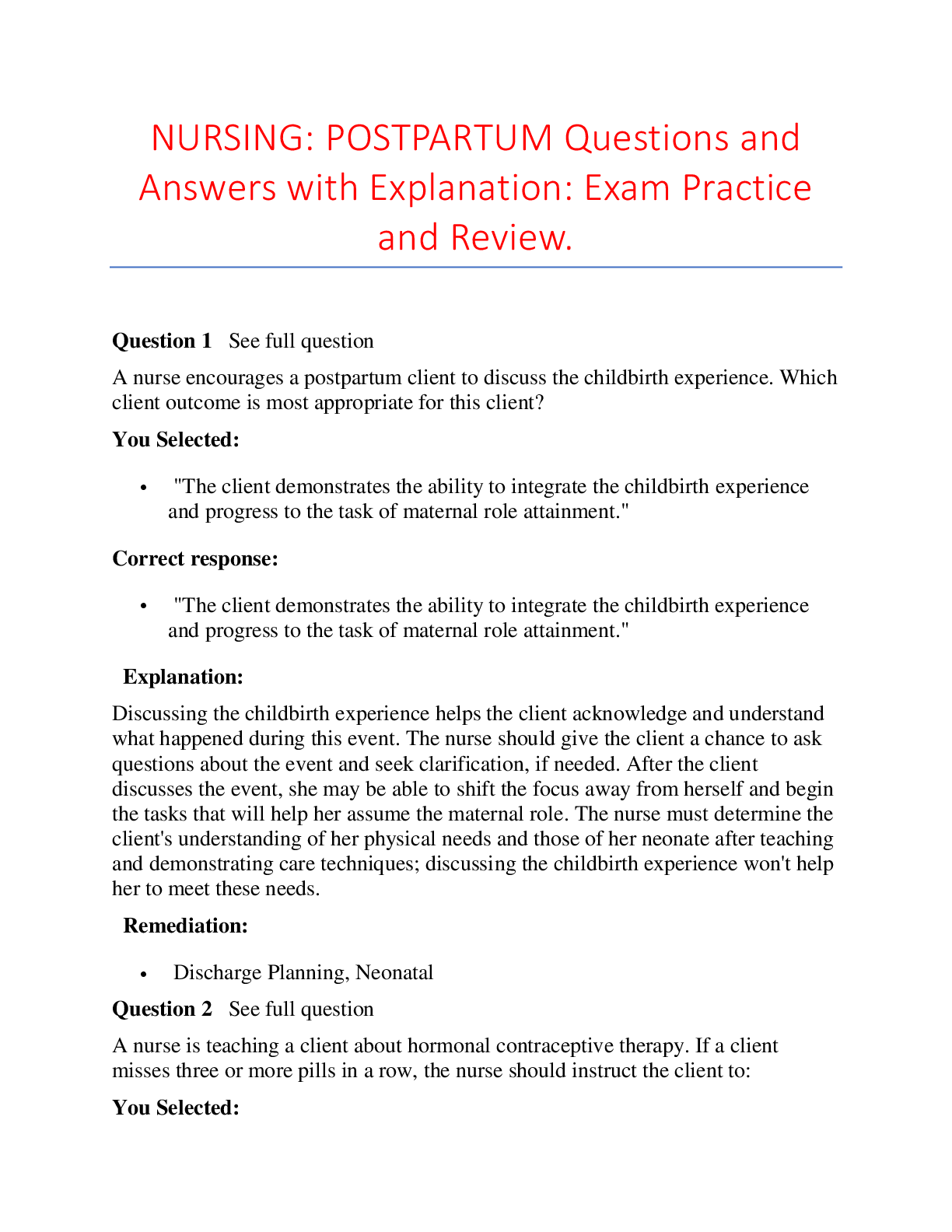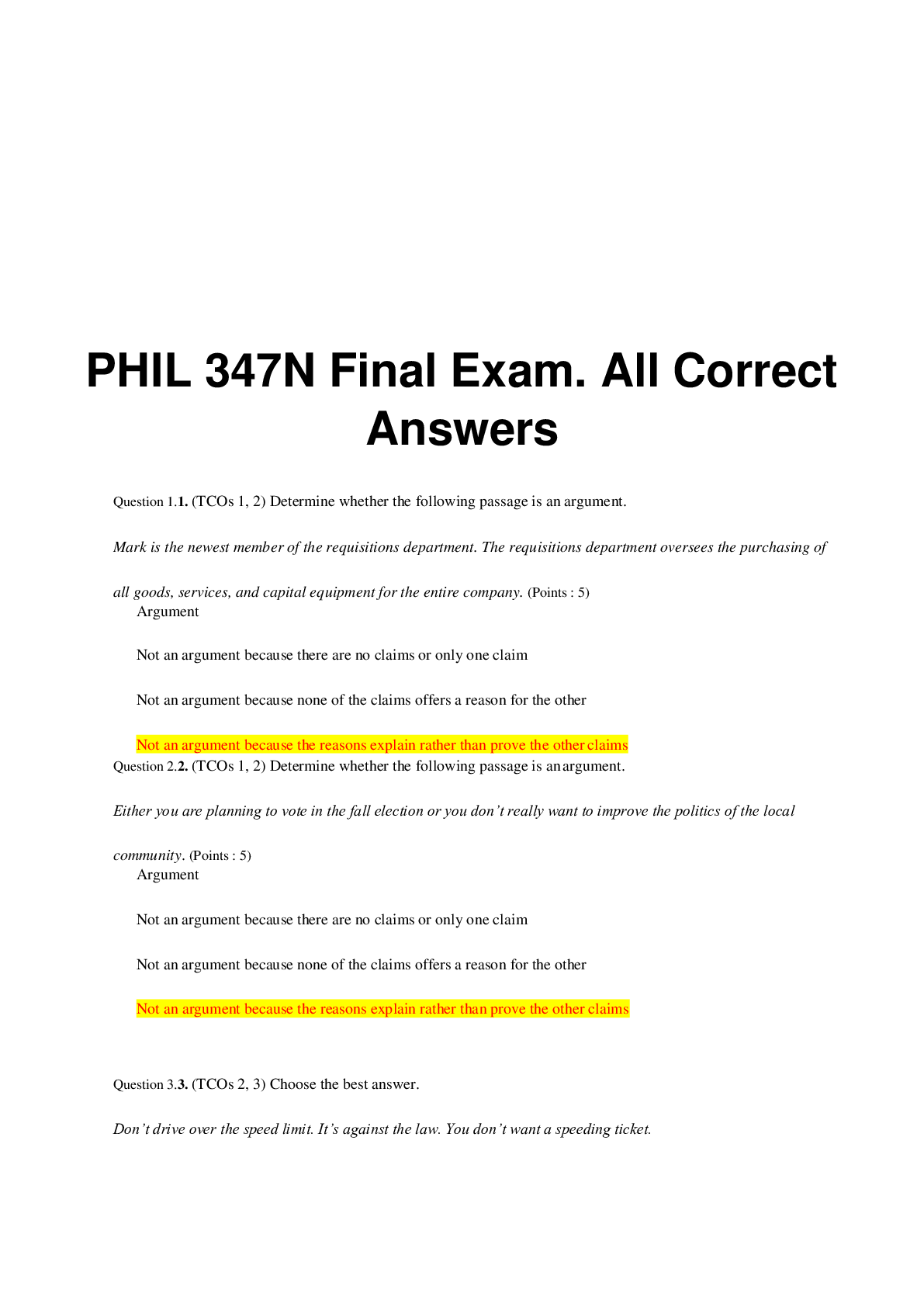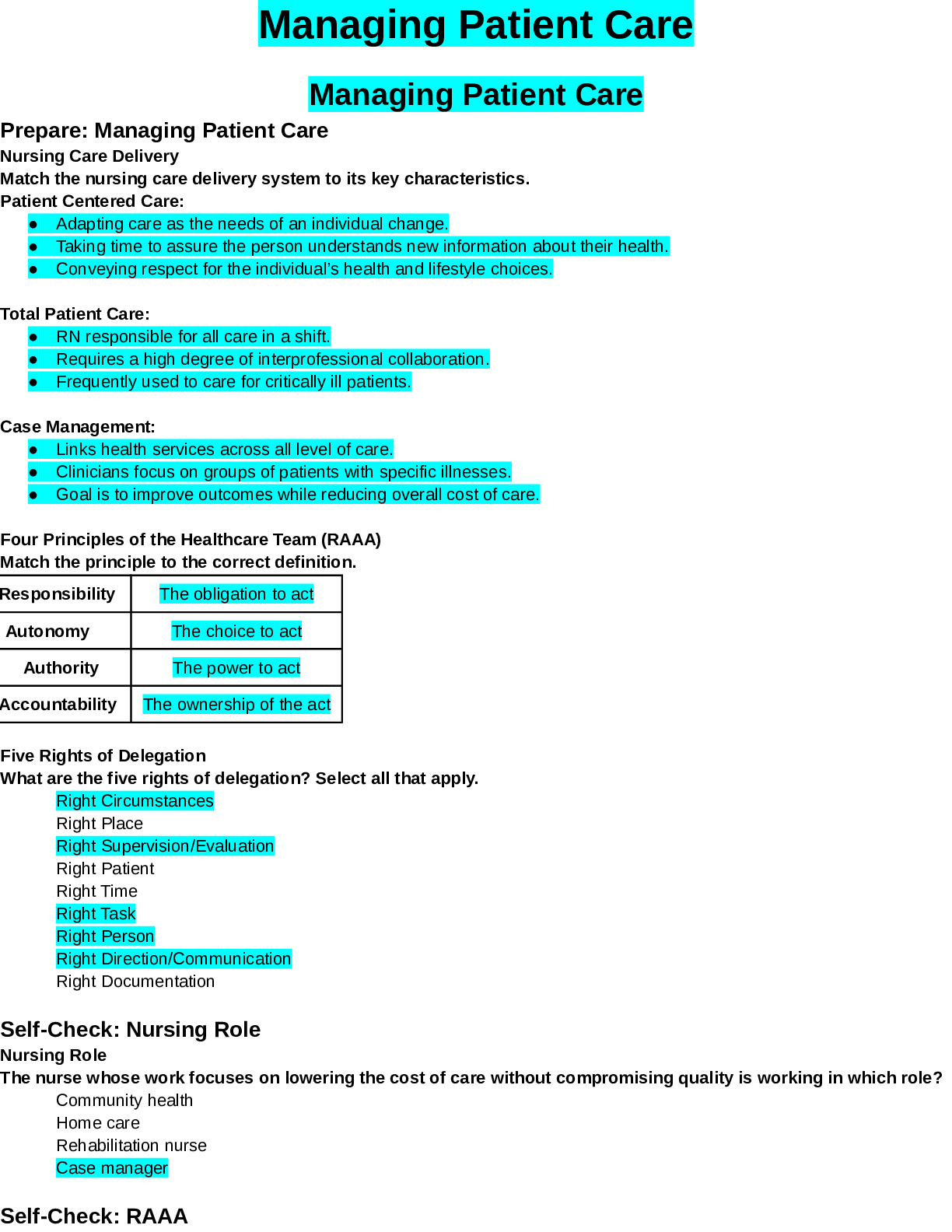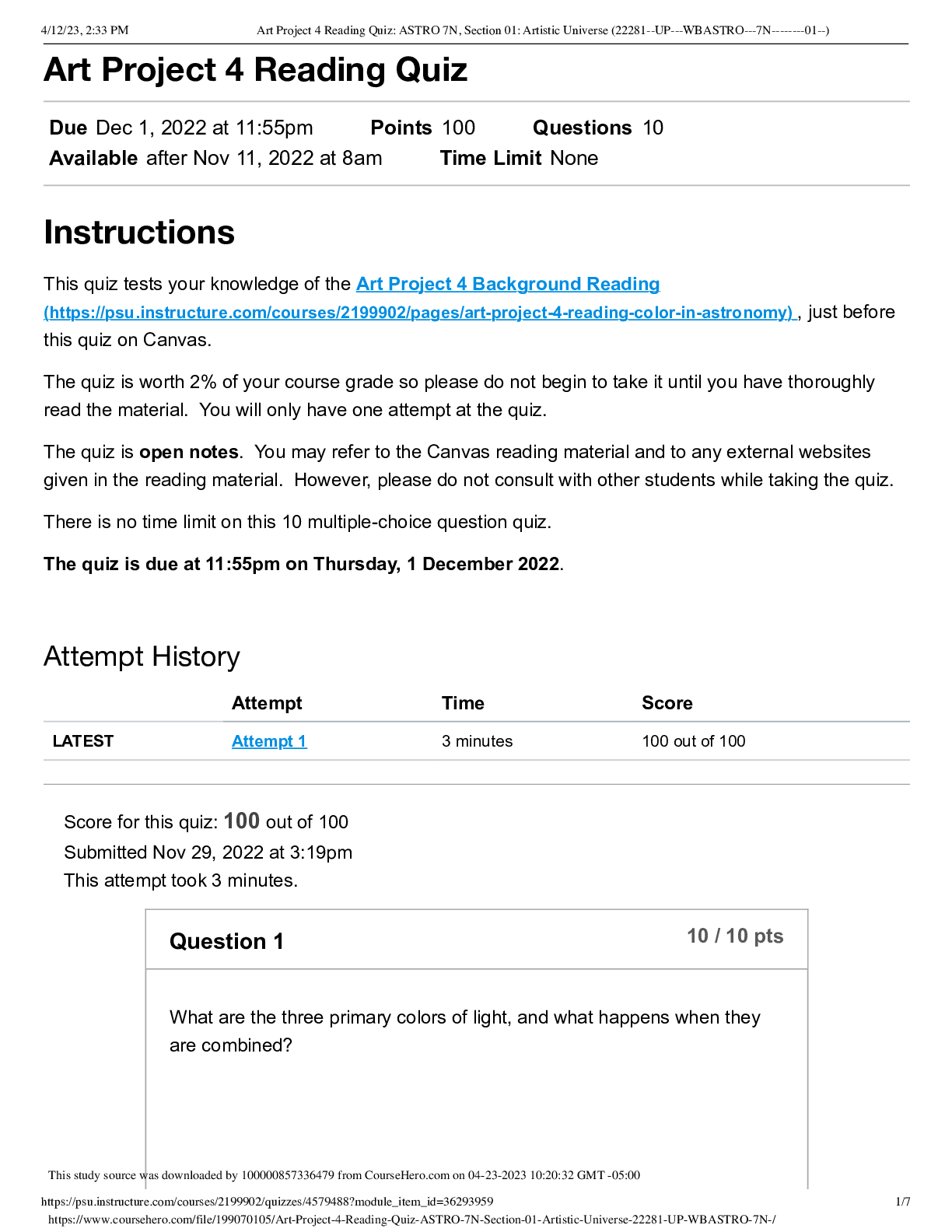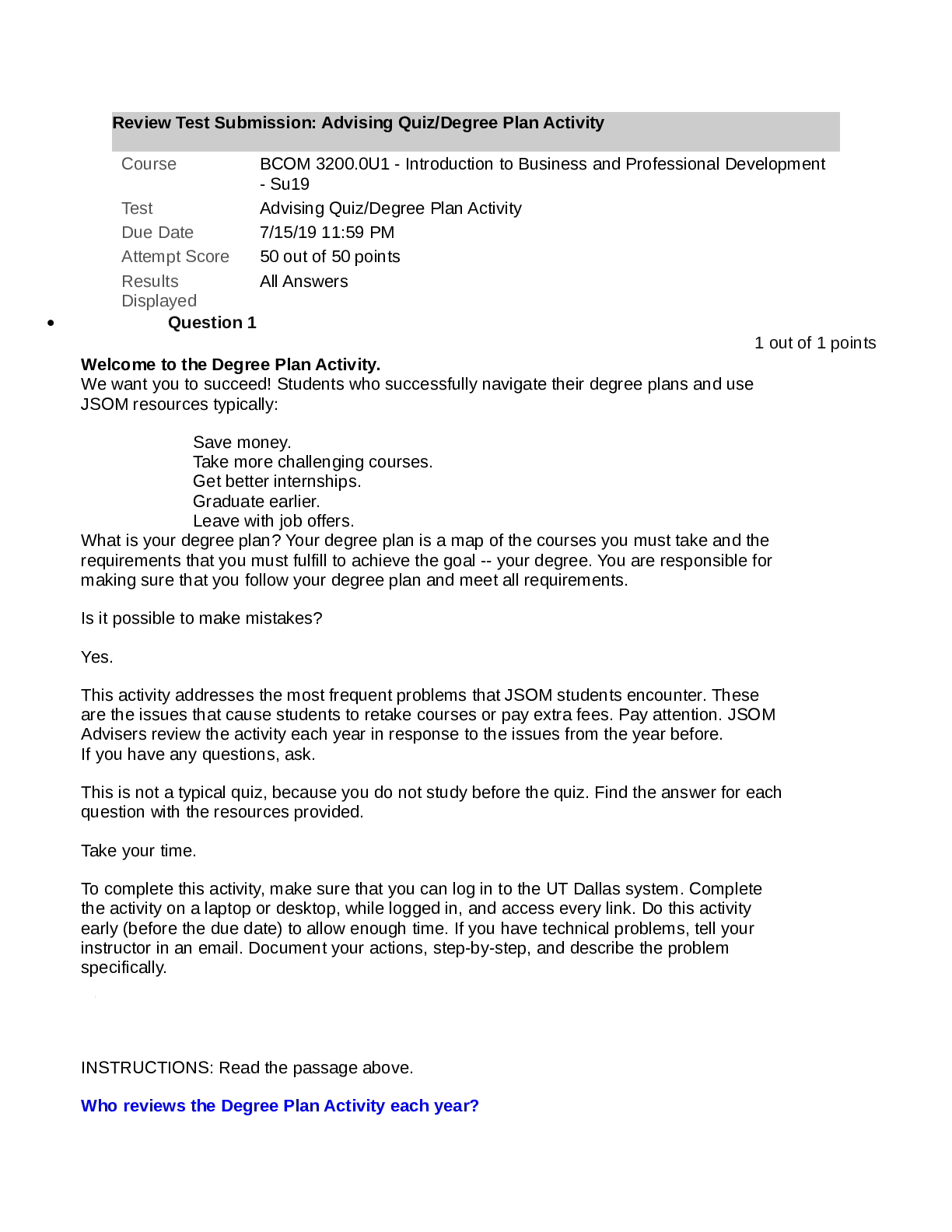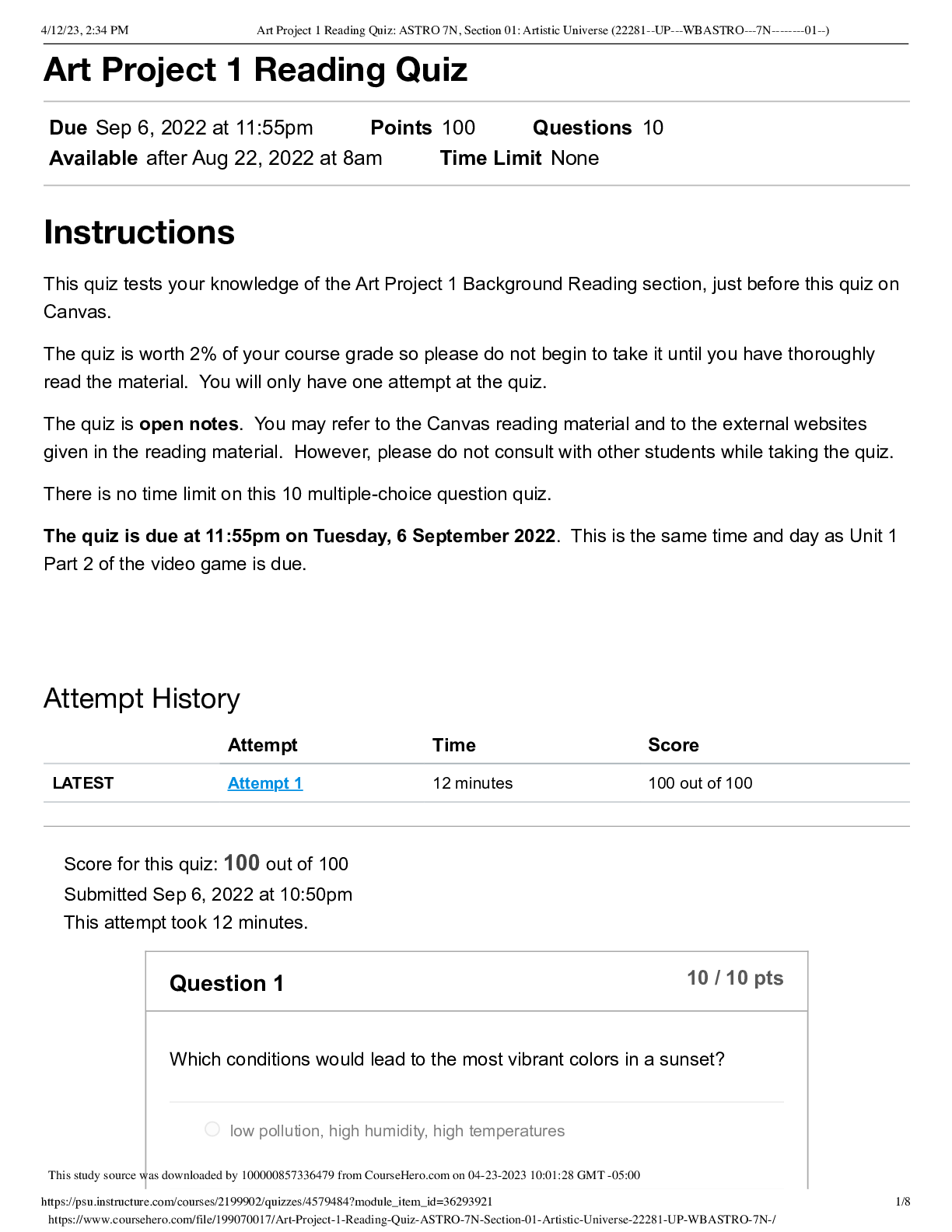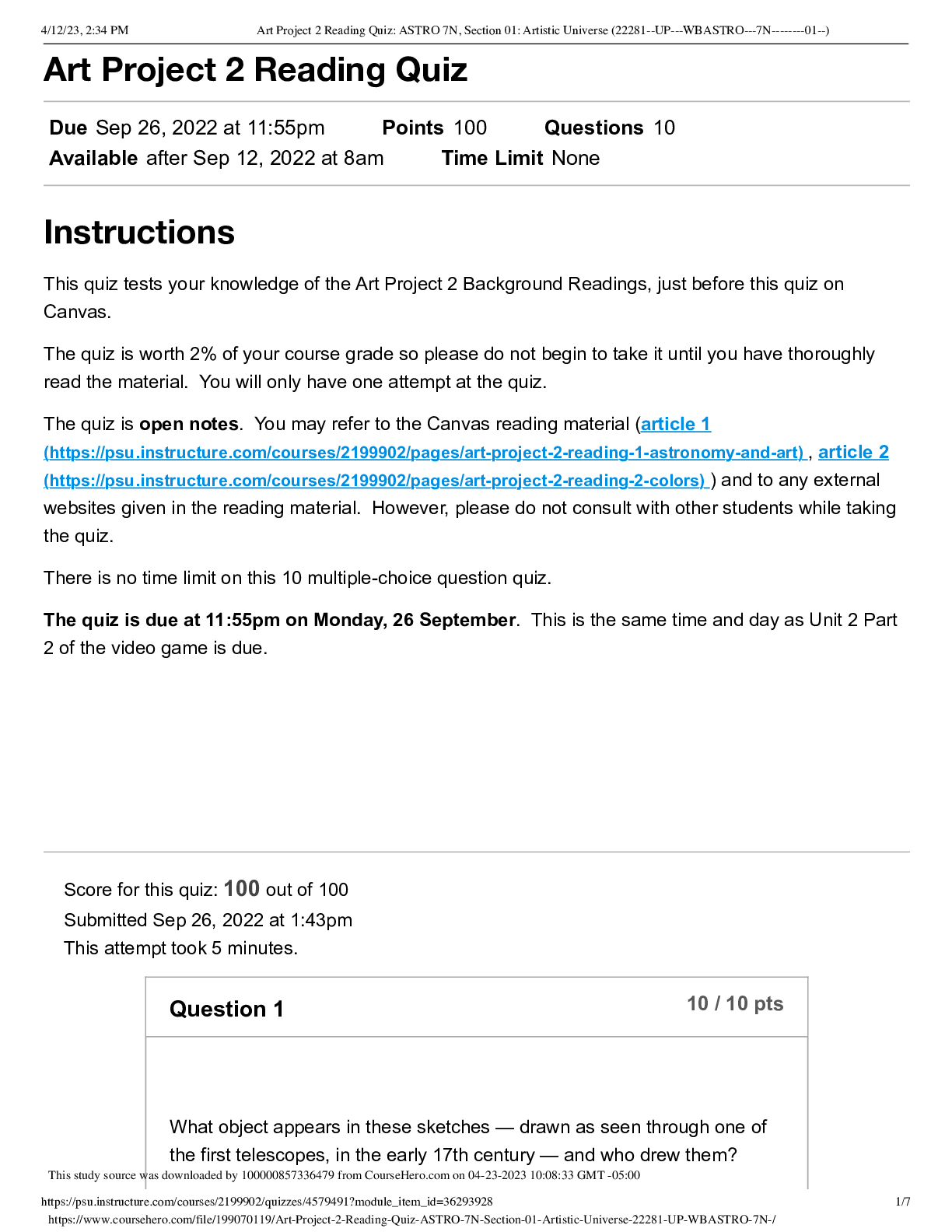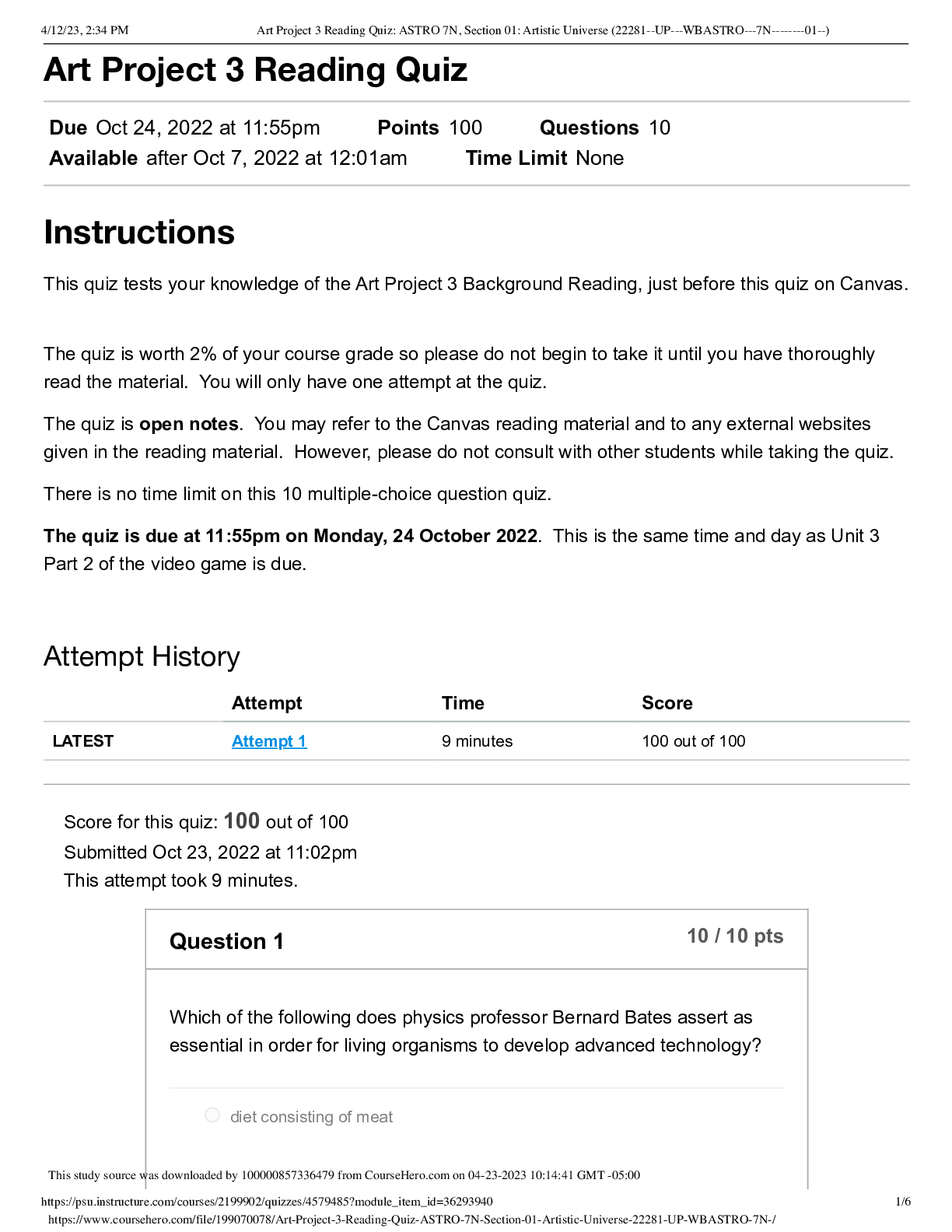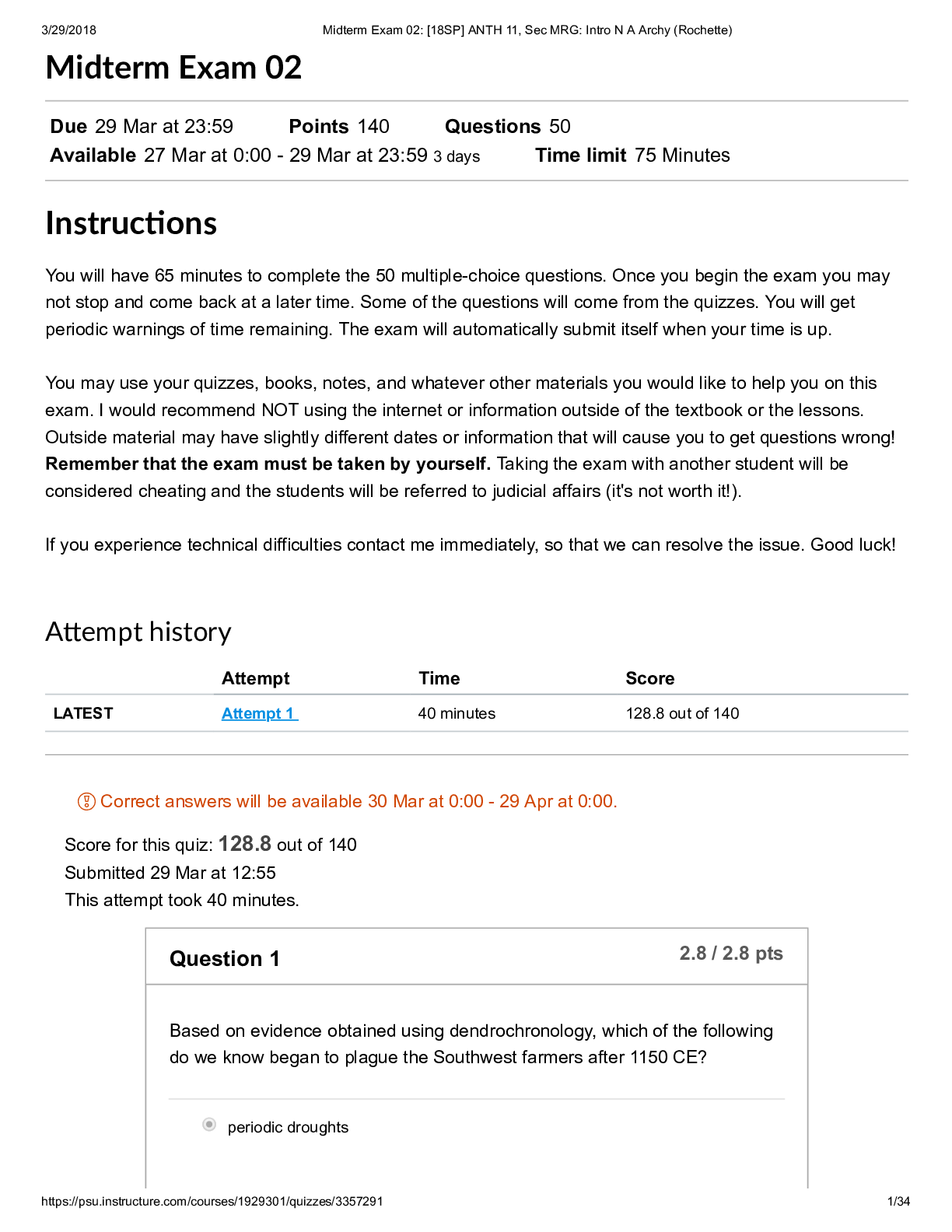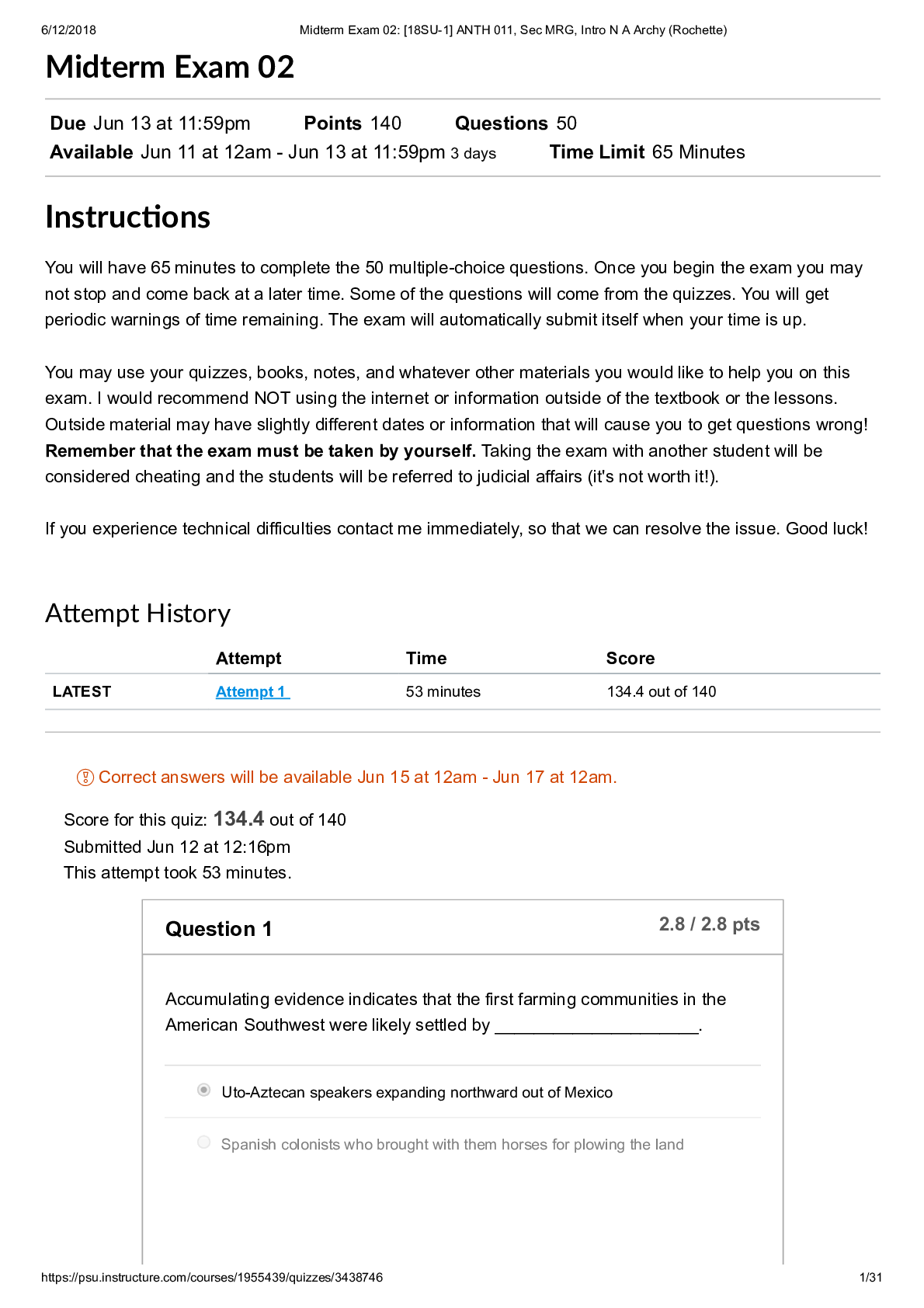Health Care > QUESTIONS & ANSWERS > University of Central FloridaSYO 4400 Medical Sociology. Exam 1: SYO 4400-19 Fall 0W60. Covers Chapt (All)
University of Central FloridaSYO 4400 Medical Sociology. Exam 1: SYO 4400-19 Fall 0W60. Covers Chapters 1-3, Score for this quiz: 50 out of 50.
Document Content and Description Below
Exam 1 Due Oct 1 at 11:59pm Points 50 Questions 50 Available Sep 30 at 7am - Oct 1 at 11:59pm 1 day Time Limit 60 Minutes Instructions Question 1 1 / 1 pts Medical sociology, as a subdi... scipline, began gaining strength: After World War II with the infusion of large amounts of federal funding for research. It was always part of sociology as a major focus of classical sociologists. 2 of 26 Only in the last two decades when major worldwide health crises highlighted the need for it. It never has been a major part of sociology and exists only as a small part of the medical field. Question 2 1 / 1 pts The scholar who first provided a major theoretical approach for medical sociology was: Parsons Durkheim Mead Goffman Weber Question 3 1 / 1 pts What important event occurred in 1951 that began to reorient American medical sociology toward the use of theory? The Vietnam War. 3 of 26 The publication of "The Social System" The increase in chronic diseases. The growth of universities. The political swing towards a more conservative era. Question 4 1 / 1 pts In the case of the sick role, illness is seen as __________, and its undesirable nature reinforces the motivation to be healthy. Deviance Normal Biological Social a stimulus Question 5 1 / 1 pts In developing his concept of the sick role, Parsons linked his ideas to which two classical theorists? Marx and Goffman. 4 of 26 Weber and Marx. Marx and Engels. Durkheim and Weber. Durkheim and Goffman. Question 6 1 / 1 pts Most sociologists of medicine are employed as: Professors at universities. Biostatisticians. Hospital workers. Researchers in governmental agencies. Independent contractors. Question 7 1 / 1 pts What trend(s) reduced tensions between sociologists in medicine and sociologists of medicine? Most government funding is awarded to research with practical application. 5 of 26 Medical sociology itself is converging with general sociology. Sociology of medicine became the more dominant side of medical sociology. A and B C and D Question 8 1 / 1 pts One of the earliest attempts in the Western world to formulate principles of health care, based upon rational thought and the rejection of supernatural phenomena, is found in the work of the Greek physician: Hippocrates Socrates House Aristotle Dioceses Question 9 1 / 1 pts The medicine of social spaces is concerned with: 6 of 26 Curing disease. Preventing disease. Understanding disease. Cataloging disease All of the above Question 10 1 / 1 pts Decline in deaths from infectious diseases in the second half of the nineteenth century was mainly due to: Improvements in diet, housing, and public sanitation. Better training of physicians. The discovery of penicillin. Epidemiological transitions. All of the above. Question 11 1 / 1 pts Unlike infectious diseases, chronic diseases typically are _____________ and ______________. 7 of 26 Short term; incurable. Short term; curable. Long term; incurable. Long term; curable. There is no difference. Question 12 1 / 1 pts With the transition to a greater prevalence of chronic diseases, physicians have increasingly had to take which approach to medical care? “Whole person” care. The clinical gaze. Use of “magic bullets.” The re-mystification of disease. Assembly-line care. Question 13 1 / 1 pts Which of the following have been significant factors in the most recent epidemiologic transition, which has seen a reemergence of infectious diseases? 8 of 26 Decreased attention to public sanitation. Globalization of trade and travel. Global warming and climate change. A and B B and C. Question 14 1 / 1 pts What caused the prevalence of STDs to soar around the globe? All of the above The birth control pill. A worldwide ideology of sexual liberation and permissiveness. A new pattern of employment in developing nations. Greater availability of multiple sexual partners. Question 15 1 / 1 pts In which study were syphilis patients intentionally not treated and allowed to die? 9 of 26 Nazi experiments. Tuskegee. STD1976. Belmont. Zimbardo prison. Question 16 1 / 1 pts Working within an atheoretical, applied approach, Parsons was the first to demonstrate how medicine functions to exert social control within the larger social system. False True Question 17 1 / 1 pts The development of institutional review boards and the Health Insurance Portability and Accountability Act have eliminated ethical concerns about issues such as clinical care, informed consent, and drug testing. False True 10 of 26 Question 18 1 / 1 pts A scientist who studies the origin and distribution of all types of diseases is best described as a(n): Epidemiologist Biochemist Social Worker Deomgrapher Sociologist Question 19 1 / 1 pts _________________ has special significance for a society because it is traditionally used as an approximate indicator of a society’s standard of living and quality of health care delivery. Infant mortality rate. Prevalence of chronic diseases. Life expectancy. Crude birth rate. 11 of 26 Age adjusted fertility rate. Question 20 1 / 1 pts What is NOT a factor in the increasing emergence of epidemics? Decrease in public sanitation. Increase in international transportation channels. Migration from rural areas into urban cities. All of the above. None of the above. Question 21 1 / 1 pts The science of epidemiology has passed through three eras and is entering a fourth. In what order did it pass through the first three eras? Sanitary, Infectious, Chronic. Sanitary, Chronic, Infectious Chronic, Sanitary, Infectious Chronic, Infectious, Sanitary 12 of 26 Infectious, Sanitary, Chronic Question 22 1 / 1 pts As a nation shifts from primarily rural-agricultural to urban-industrial, what changes are seen in the health profile of the nation? Leading causes of death change from mostly infectious diseases to chronic diseases. Leading causes of death change from mostly chronic diseases to infectious diseases. Infectious diseases are eliminated entirely Both infectious and chronic diseases are reduced to a minimum. There is no difference Question 23 1 / 1 pts What is the leading cause of death in the United States, accounting for more than one-third of all deaths? Diabetes 13 of 26 HIV/AIDS Stroke Heart Disease Cancer Question 24 1 / 1 pts What do studies on diet, exercise, and obesity suggest with respect to heart disease? Changing one’s eating habits toward a diet low in saturated fat can reduce the risk of developing heart disease. Diet and physical activity have little effect on an individual’s likelihood of developing heart disease. Obesity is the result of individual choices and relates little to the development of heart disease. Only lengthy, vigorous physical activity has been shown to provide some protection against heart disease. None of the above. 14 of 26 Question 25 1 / 1 pts AIDS now affects _____________ in Africa more than ________________. women; men whites; natives children; adults homosexuals; heterosexuals men; women Question 26 1 / 1 pts ___________ appears to be a major channel for AIDS transmission in India. Prostitution Mother to child transmission Overcrowding Improper sanitation Marijuana use. 15 of 26 Question 27 1 / 1 pts People who become infected with HIV may be subjected to discrimination, which can isolate them socially. This social outcome is: Stigma Stagflation Disintegration Disentanglement All of the above Question 28 1 / 1 pts Which of the following demonstrates the sociological implications of the HIV/AIDS epidemic? Its influence on modifying social norms, values, and lifestyles. How certain social behaviors lead to the transmission of the disease and result in a pandemic. The social rejection of AIDS patients. Moral and religious debates over the meaning of the disease and treatment options. 16 of 26 All of the above Question 29 1 / 1 pts Which term describes an individual’s most important position in society and typically comes from one’s occupation? Master Status Default Status Ordinary Status Primary Status Main Status Question 30 1 / 1 pts Since AIDS results from a private act that has extreme social consequences, serious moral and legal questions also arise about the rights of ____________ versus the welfare of _______________. Individuals, society. Individuals, government. Hospitals, individuals. 17 of 26 Hospitals, society. Government, society. Question 31 1 / 1 pts Which of the following best describes influenza pandemics? They are unpredictable and occur at irregular intervals. They occur frequently but the threat to worldwide health is minimal. They have been mostly eliminated due to the development of vaccines such as Tamiflu. They are easily contained to the region of outbreak. None of the above Question 32 1 / 1 pts Crude death and birth rates are too gross a measure to be meaningful for most sociological purposes True False 18 of 26 Question 33 1 / 1 pts Smoking is the leading cause of sudden cardiac death in the United States and quitting smoking nearly eliminates this risk after a year or two. True False Question 34 1 / 1 pts Several studies find that the strongest and most consistent predictor of a person’s health and life expectancy is Social Class Psychological profile Neighborhood. Gender Income Question 35 1 / 1 pts 19 of 26 The lower class would include: Affluent well-educated professionals and high-level managers. Semi-skilled and unskilled workers, the chronically unemployed. Office and sales workers, small business owners, teachers, managers. Skilled and semi-skilled workers, lower-level clerical workers. All of the above. Question 36 1 / 1 pts Social status is a(n) ___________ dimension in “social class” consisting of how much esteem the person is accorded by other people. Subjective Objective. The most important Hidden None of the above Question 37 1 / 1 pts 20 of 26 According to Weber, _________ is the ability to realize one’s will even against the resistance of others. Prestige Presence Principle Power None of the above Question 38 1 / 1 pts In quantitative studies, what variables are used to measure socioeconomic status? Income, occupational prestige, and education. Social and human capital. Income and wealth. Status, wealth, and power. Neighborhood characteristics. Question 39 1 / 1 pts 21 of 26 Which component of social class is consistently the strongest single predictor of good health? Human Capital Power Neighborhood Education Income Question 40 1 / 1 pts New research is showing that the relationship between occupation, income, education, and health changes over the life course, with __________ becoming more important for health as a person moves toward older age. Income Occupation Education All of the above None of the above 22 of 26 Question 41 1 / 1 pts According to Richard Wilkinson, which is the most important variable influencing a county’s overall level of health? Income inequality within a country. Degree of modernization. Access to quality health care. Overall wealth of the country. Cultural lifestyles that promote health. Question 42 1 / 1 pts Compared to other social classes, lower class individuals visit physicians _________. More Often The same amount Less Often Not at all None of the above 23 of 26 Question 43 1 / 1 pts The cause(s) of the social gradient is most likely related to differences between socioeconomic groups and classes in: Some combination of all of the above. Self-esteem and stress levels. The effects of income inequality. Deprivation through the life course. Health lifestyles and social support. Question 44 1 / 1 pts What 1980 report in Great Britain dispelled the notion that social class differences were becoming less important because of the growth of state welfare services? Black Report Health in Britain. Disparities Report Whitehall Report None of the above 24 of 26 Question 45 1 / 1 pts Heart disease has been decreasing in Japan due to the spread of Western medicine. False True Question 46 1 / 1 pts The finding that even the upper middle class lives shorter than the uppermost class, and that every class lives longer than the one directly below it is evidence of what? Social gradient in mortality. Educational differences. Influence of deprivation. Social patterning of disease. None of the above Question 47 1 / 1 pts Neighborhood disadvantage focuses on: 25 of 26 Poor neighborhoods Minority populated neighborhoods Southern States with high poverty rates Unhealthy urban living conditions. None of the above Question 48 1 / 1 pts Which of the following is NOT one of the features of neighborhoods that can influence health? Racial make-up of the neighborhood Physical environment Support services Sociocultural aspects Reputation of an area Question 49 1 / 1 pts The “fundamental social cause” thesis suggests that social class contributes to poor health and mortality, but is not a direct cause. 26 of 26 True False Question 50 1 / 1 pts Recent evidence has found that unemployment itself does not cause deterioration in mental health. False True Quiz Score: 50 out of 50 [Show More]
Last updated: 2 years ago
Preview 1 out of 26 pages

Buy this document to get the full access instantly
Instant Download Access after purchase
Buy NowInstant download
We Accept:

Reviews( 0 )
$7.00
Can't find what you want? Try our AI powered Search
Document information
Connected school, study & course
About the document
Uploaded On
Jul 31, 2022
Number of pages
26
Written in
Additional information
This document has been written for:
Uploaded
Jul 31, 2022
Downloads
0
Views
96

